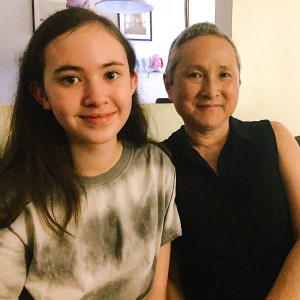Age: 13
Neighborhood: SoHo
Current School: Lower Manhattan Community Middle School
First Choice: Beacon High School
Admitted: Baruch College Campus High School

Sen Oglesby, who loves watching horror movies, is an eighth grader at the Lower Manhattan Community School, a small, high-achieving, racially mixed school in the Financial District. For her, choosing the right high school meant finding one that had enough Advanced Placement classes for her to get a jumpstart on college credits.
The eighth grader relied on advice from her upper middle class parents and from her school counselor, someone she has worked with since the seventh grade. “Both my parents and guidance counselor told me to choose a school that I would enjoy,” she said. Sen wanted a college prep school. Her mother urged her to go for racial diversity, plus an 85 percent graduation rate or above.
“It’s important for her to know people from different backgrounds, cultures, experiences,” said Shino Tanikawa, president of the Community Education Council (CEC) in Manhattan’s District 2. “I wanted to find a school environment where you can learn from people from all over.” Tanikawa was born and raised in Japan and Sen is Asian-Caucasian.
Mother and daughter did not always agree. Tanikawa liked Frank McCourt High School on the Upper West Side. Sen thought the teaching style, which centers on group work, was not right for her.
Sen also considered the daily travel time to and from school when organizing her list. She said, “We talked about how the commute would work to and from school and also the hours of the day to make sure that there will still be time to do stuff after school.” She takes a modern dance and an Algebra Regents class.
In all, they visited 11 schools and listed nine for the first round pick.
Her classmates also played a role. Beacon High School, one of the city most sought-after schools, was her top choice and is a popular pick at her middle school. Sen’s second choice was Baruch College Campus High School. Located in the Flatiron district, it gives admissions priority to students who live in the area and requires an in-person interview.
Because of her work with the Community Education Council, Tanikawa was able to solicit feedback from her contacts in the area’s high schools. “It’s been a big help because I know that there are a lot of good schools out there and not just the ones that are popular,” she said. The city’s 32 CECs serve as liaison between the public and the New York City Department of Education. Each council approves school zoning lines, reviews district educational proposals and evaluates its district superintendent.
Sen was matched with Baruch, her second choice. “At first, I felt very self-conscious or unsure of myself because I did not get into Beacon,” she said in a voice more mature than her 13 years. “I slowly came to the realization that I liked Baruch much better. I only put Beacon as number one for social reasons.”
Data from the New York City Department of Education’s 2014-2015 school year showed that Baruch had a 100 percent 4-year graduation rate and a 91 percent college enrollment rate. New York City’s average rate is 70 percent and 53 percent, respectively. The school, which has 451 students, is 55 percent Asian, 24 percent White, 14 percent Hispanic and 6 percent Black.
About 37 percent of Lower Manhattan Community Middle School students met state English standards in 2014-15 and 42 percent met the math standards. Both are considerably higher than the citywide average, which was 30 percent and 31 percent, respectively. The school, which has 366 students, is 40 percent Asian, 22 percent White, 21 percent Hispanic and 14 percent Black.
Baruch had all of the things Sen wanted in a high school and it also matched the feel and style of her middle school. “My middle school is very diverse. They believe in independent work and collaboration,” she said.
